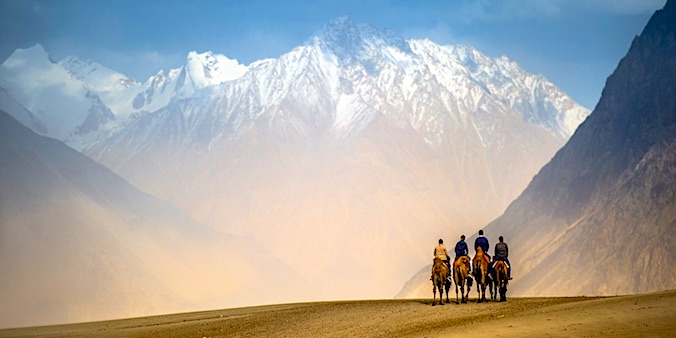LADAKH - NEBUK LA TREK
Tour - 19 days/ 9 days trekking
Nebuk La Trek
Tour 19 days/ 9 days trekking
About LADAKH
Ladakh is a part of the Indian Himalayas It is located between the Kunlun mountain range in the north and the main Himalayas to the south. Although part of India now, and earlier of the princely state of Kashmir, Ladakh has been an independent kingdom for almost 900 years.
Ladakh is well-known for its starkly beautiful mountain scenery. As a result of its location in the rain shadow of the main Himalayan Range its climate is extremely dry, and due to the high altitude – most valleys are situated at 3300m or higher – winters can be extremely cold. Summers, however, are generally pleasant if not warm and sunny. Ladakh is inhabited by a mix of Indo-Aryan and Tibetan people. Especially the latter, with their colourful buddhist culture, have given the region the nickname of ‘Little Tibet.’
Ladakh in the narrower sense is the Indus Valley with adjacent areas. It is bordered by two mountain ranges: in the northeast by the Ladakh Range, in the southwest by the Zanskar Range. The area around the capital Leh, and further upstream towards Tibet, is referred to as Upper Ladakh. Lower Ladakh is the area further downstream to Kargil, where the Indus enters Pakistan.
The remoter areas of Zanskar, Nubra and Rupshu are now seen as regions of Ladakh. In the past, these areas were sometimes part of Ladakh, sometimes not. They can be visited from Leh by car or on foot. The latter should be your preferred mode of transport, if you are up to it. Because, while jeep trips in Ladakh are very rewarding indeed, trekking will give you an even more in-depth experience of the land and the people, with the added bonus of a total renovation of body and soul.
Ladakh can be reached by air or overland. On this tour you fly in and out. In case you have enough time available, we strongly recommend to take the overland route, in which you travel by train and car to Ladakh through Manali, in the Himalayan state of Himachal Pradesh. This is one of the greatest car journeys in the world.
Region
Ladakh
(India)
Best Time
July - Sept.
No. Of Days
19 days,
9-day trek
Trip Character
Trekking tour
Sleeping Altitude
3500 - 4700 m.
Trek Character
Camping trek
Level: 3
Price
INR XXX/ $ XXX
ABOUT THIS TOUR
In the old days, seven caravan routes converged at Leh, the capital of Ladakh. The most profitable one connected Kullu Valley (present day- Himachal Pradesh) with Yarkand in Turkmenistan.
Along this trail, the highly valued Kullu-opium was taken to China. We intend to revive it with our own modest caravan, trekking into the hidden valleys of Nubra and Shyok. Along a unique route, we descend to the Shyok River. Here, at the foot of the Karakoram, we stay for a few days in our own very comfortable community-based lodge in a traditional village.
After exploring the area around Shyok and visiting the legendary Pangong Lake (only 2 hours away from Shyok), we follow the Shyok River down to Nubra, where we have a full day to see some amazing monasteries, partly on foot, and ride Bactrian camels in a semi-desert of tall sand dunes. We return to Leh by crossing the 5450m high Khardong La, this time by car.YOUR custom-made TRIP
The tour described here, as well as the other ones on our website, are mainly meant as suggestions. We would be happy to offer you a travel proposal that fully meets your personal demands and expectations. That means that you choose where you want to go, what level of accommodation and type of transport you want and what activities you prefer.
Please let yourself be inspired by this and other trips on our website and then drop us a line (or call us up) to explain your travel wishes. We will be happy to help you put together the perfect trip. You can reach us over e-mail, Messenger, Whatsapp or mobile phone.
EXTENSIONS & VARIATIONS
Apart from the tour as described here, you could consider the following add-ons and changes:
- Stay one or two days longer in Leh before you start the trek, in order to acclimatize, but als to explore the Indus Valley east and west of Leh with its many mesmerizing monasteries.
- Explore the Shyok River further downstream in the direction of Pakistan. The road passes through magnificent gorges and while the vegetation gets more opulent as you are reaching lower altitudes the culture gradually changes from predominantly Buddhist to Muslim. You can travel up to the village of Turtuk where you can stay the night at a simple but decent tented camp.
- Spend one more day in Nubra on which you make a 5-hour walk to two small, hidden monasteries that rarely if ever see a foreigner coming.
- Do an even more challenging trek or longer trek instead of the Nebuk La trek. For instance, the Rumtse – Kibbar trek. On this 18-day trek you traverse the high plateau of Changtang, an area similar to the south side of the Nebuk La, but even more grandiose. See here.
- Spend a day rafting on the Indus. There are different grades available, so there is the easy but fun to do level as well. Professional oarsmen will be with you in any case. You will be picked up from your hotel and dropped off there again at the end of the day, a pic-nic lunch is included.
ITINERARY
-
Day 1: Flight Delhi - Leh
The flight from Delhi to Leh takes only 1 hour but, on a clear day, is breathtaking. Stepping down from the aircraft you may feel the altitude, but even if you don’t, it is very wise to take the rest of the day off. Stay at the hotel or at best walk around Leh bazar. Altitude 3500. -
Day 2 & 3: In Leh
If you wake up without a headache you may consider yourself fit to go on not too strenuous walks or excursions in and around Leh. Else, better to stay at the hotel another day. Altitude: 3500m. -
Day 4: Leh - Sabu Phu & Trekking Sabu Phu - Sabu Pullu (drive 1 h, walking 4 -5 h)
After a short ride you reach the start of the trek, at 4400m, where the trekking crew (guide, cook, horsemen) and pack horses await you. Camp is made after a steady climb with nice views of the glaciated Zanskar Range. Altitude 3500 → 4400 → 4700m. -
Day 5: Acclimatization at Sabu Phullu
Day of acclimatization to the altitude. One or more short hikes can be made without climbing too much. Altitude 4700m. -
Day 6: Trekking Sabu Pullu - Digar La - Chumik Gongma (7 - 8 h)
After the long climb to Digar La (5380m) you are rewarded with unforgettable views of the Zanskar Range and Karakoram, including Saser Kangri, India's highest peak (7672m). You descend to summer meadows with small shepherds' huts. Altitude 4700 → 5380 → 4630m. -
Day 7 & 8: Trekking Chumik Gongma - Kyema
The next two days there are two options. The easiest way involves an overnight near beautiful Digger village (3950m) and then via a dirt road to Kyema overlooking the Karakoram. A more adventurous route crosses two low mountain ridges over hardly used mountain paths with overnight camp halfway. Altitude 4630 → 4000m. -
Day 9: Trekking Kyema - Tanggyer (4 - 5 h)
Climb to Kyema La (4500 m) with fantastic views of the dramatically situated village of Tanggyer barley fields around Tanggyer, where you camp. Altitude 4000 → 4500 → 3800m. -
Day 10: Trekking Tanggyer - Jukti (3 - 4 h)
Early morning village yaks and goats are collected to graze on higher meadows. We climb the slope north of the valley to Jukti. Search for traces of wolves and snow leopards! Altitude 3800 → 4500m. -
Day 11: Trekking Jukti - Rele (8 h)
After a 5 hour climb Nebuk La (5400m) is reached. The last part is steep and gravelly with probably a thick layer of snow. Nice view of valleys of Rele and Tangtse. You descend to the summer village of Rele. Altitude 4500 → 5400 → 4400m. -
Day 12: Trekking Rele - Shyok (4 h)
You descend over a rough jeep track towards the wide valley of Tangtse, then follow the legendary winter caravan route from Leh to Turkmenistan (an abandoned mountain trail now). Overnight in comfortable Shyok River Lodge. Altitude 4400 → 3700m. -
Day 13: In Shyok (8 h)
Today you'll be taken on village and nature walks near Shyok. You'll learn a lot about the Ladakh way of life and the Ladakhi flora and fauna. Altitude 3700m. -
Day 14: Visit Pangong Tso (4 h)
Today you'll be taken by car to the spectacular, cobal-blue high latitude lake Pangong Tso. It sits right on the border of Ladakh and Tibet (India & China). Altitude 3700 → 4300 → 3700m. -
Day 15: Shyok - Nubra (4 h)
A thrilling jeep ride awaits you today, along the untamed Shyok river to Nubra. The road follows the beautiful valley, passing small hamlets of Ladakhi farms, crossing sand dunes and small side-rivers. Altitude 3200m. -
Day 16: In Nubra
Today will be spent in Nubra. You can visit some beautiful Buddhist monasteries, ride Bactrian camels through the sand dunes of Hundar or hike to small, hidden monasteries. Altitude 3200m. -
Day 17: Nubra - Leh (4 -5 h)
The road from Nubra Leh crosses the Khardung La (5450 m). This is supposed to be the highest motorable road in the world. The drive is spectacular and so are the views over the oasis of Leh during the descent. Altitude 3200 → 5450 → 3500m. -
Day 18: In Leh
A last day in Leh to buy souvenirs and to get organised for the trip back home. Or to go on a rafting trip on the Indus River. Altitude 3500m. -
Day 19: Flight Leh - Delhi
After an early breakfast, the taxi will take you to the airport.
HIGHLIGHTS OF THIS TOUR
Flight to Leh
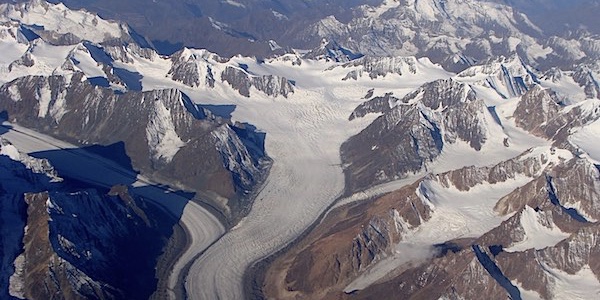

LEH
CARAVAN ROADS OF LADAKH
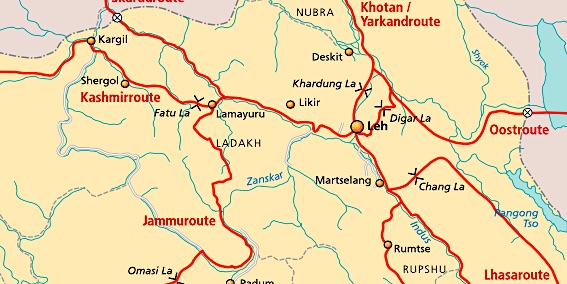
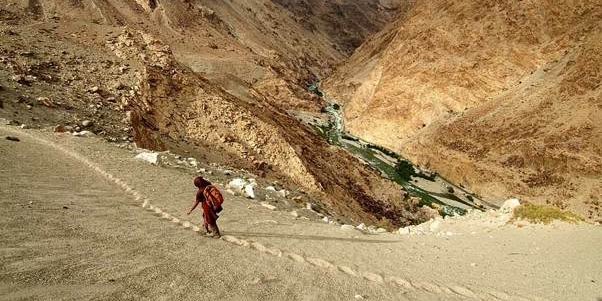
NEBUK LA TREK
SHYOK RIVeR LODGE

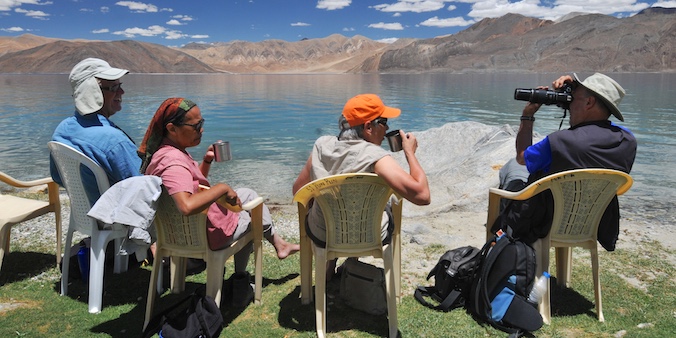
PANGONG Tso (LAKE)
NUBRA VALLEY
